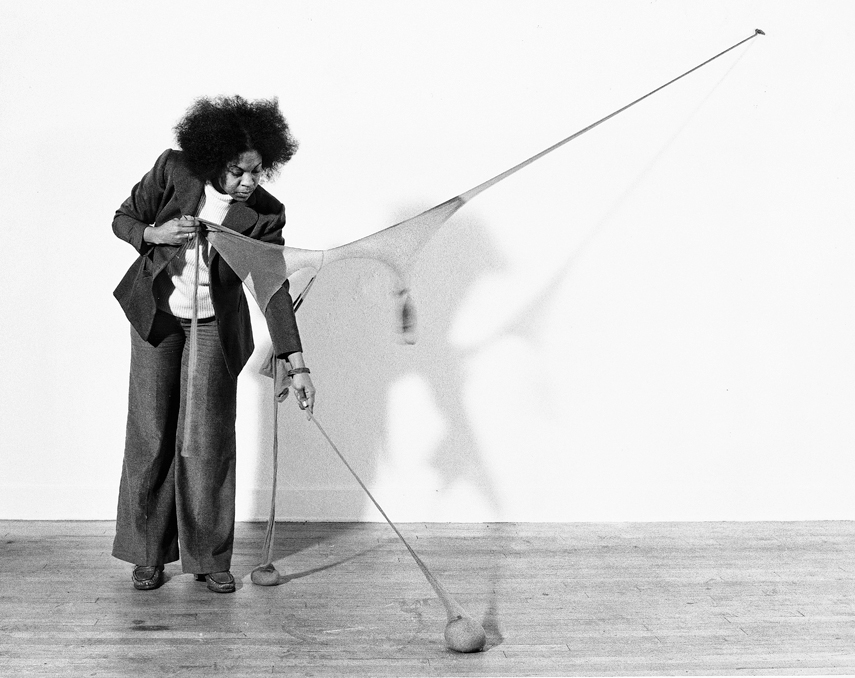Hammer Museum to feature 'Kiss,' an exhibition showcasing African American art

Senga Nengudi is shown setting up nylon mesh, sand and dried rose petals for a performance. “Kiss” will be recreated at the Hammer Museum on Sunday.
Credit: Hammer Museum
“Kiss”
Sunday, 2 p.m.
Hammer Museum, FREE
By Dan Peel
Sept. 30, 2011 2:26 a.m.
Museums no longer dismiss knotted pantyhose and sand sculptures, but rather showcase them on their exhibit walls as art.
“Kiss,” an opening celebration for “Now Dig This!,” an exhibition opening at The Hammer Museum, will feature art by Senga Nengudi, Maren Hassinger and Ulysses Jenkins. The event is presented by Pacific Standard Time, a collaboration of 60 cultural institutions, and will display 140 works from 35 African American artists.
Columbia University Professor Kellie Jones will curate the exhibitions and lead people through the exhibit and into the black-box auditorium of the Billy Wilder Theater, where the three artists will perform together for 10 to 15 minutes.
According to Nengudi, artist and University of Colorado at Colorado Springs visual and performing arts professor, the original “Kiss” took place in 1981, where the artists supported each other’s concepts and performed in each other’s pieces. Clips from the original “Kiss” will play at the Hammer.
The performance will evoke themes of self-love and self-appreciation, Nengudi said.
“It’s not as X-rated as it might sound,” Nengudi said. “We do a lot of … kissing of ourselves in it. That’s why … (the title) evolved into (“˜Kiss’).”
Performance art is not the same as performing arts. According to Nengudi, it is based on a concept in action, and does not require rehearsal.
“You can have a ballerina dance across the stage while you eat cornflakes with chopsticks,” Nengudi said. “(Or) it can be as simple as someone sitting at a bus stop all day.”
According to Nengudi, the museums of the 1960s were very dismissive of this type of art.
“Senga and Ulysses and I have worked … very hard … for almost 40 years now,” said Hassinger, director of the Rinehart School of Sculpture at the Maryland Institute College of Art. “We have suffered from being excluded. In some ways, it’s very nice that we were included in this show. In other ways … it doesn’t have as much meaning for us now as it did … years ago.”
Nengudi’s art is composed of media such as pantyhose, sand, fossils, rocks, masking tape and seed pods. Hassinger sculpts lengths of wire rope and chain links into shapes that often bear resemblance to living plants. She then arranges these sculptures into savanna-like exhibits in galleries or in parks.
Jenkins, artist and professor of studio art and video art production at Otis College, makes image-rich videos to tell a story. In “Mass of Images”, Jenkins rolls out from behind a stack of dead TVs in a wheelchair with a plastic mask on his face and a sledgehammer in his hand.
“This work is not some kind of knick-knack,” Jenkins said. “People have tried to categorize African American art as naïve. It’s very sophisticated artwork that people are going to run into at that show.”
According to Nengudi, she became fascinated with the resilience of the human body and mind, and experimented with items such as bronze, which failed to capture the concept of physicality.
“The pantyhose I found had an elasticity … like the body and the sense of body just by the color,” Nengudi said.
Sand gave the sculpture the weight and sensuality of the body, Nengudi said.
According to Hassinger, she sculpts savannas because they have a major significance to humanity.
“Every person on this earth was spawned in an environment with a savanna,” Hassinger said. “The practice of art has a lot to do with channeling information from the past. I don’t know how the information comes to me, but … there are many instances after I’ve made something where I discover its significance to … how we began.”
Cultural aesthetics is the reason for limited public appreciation of their art, Jenkins said.
“African … artists use an expression of beauty which does not compute to people who are of a Eurocentric background,” Jenkins said. “They have a problem of seeing the beauty not only in (African) artwork, but in who we are as a people.”


